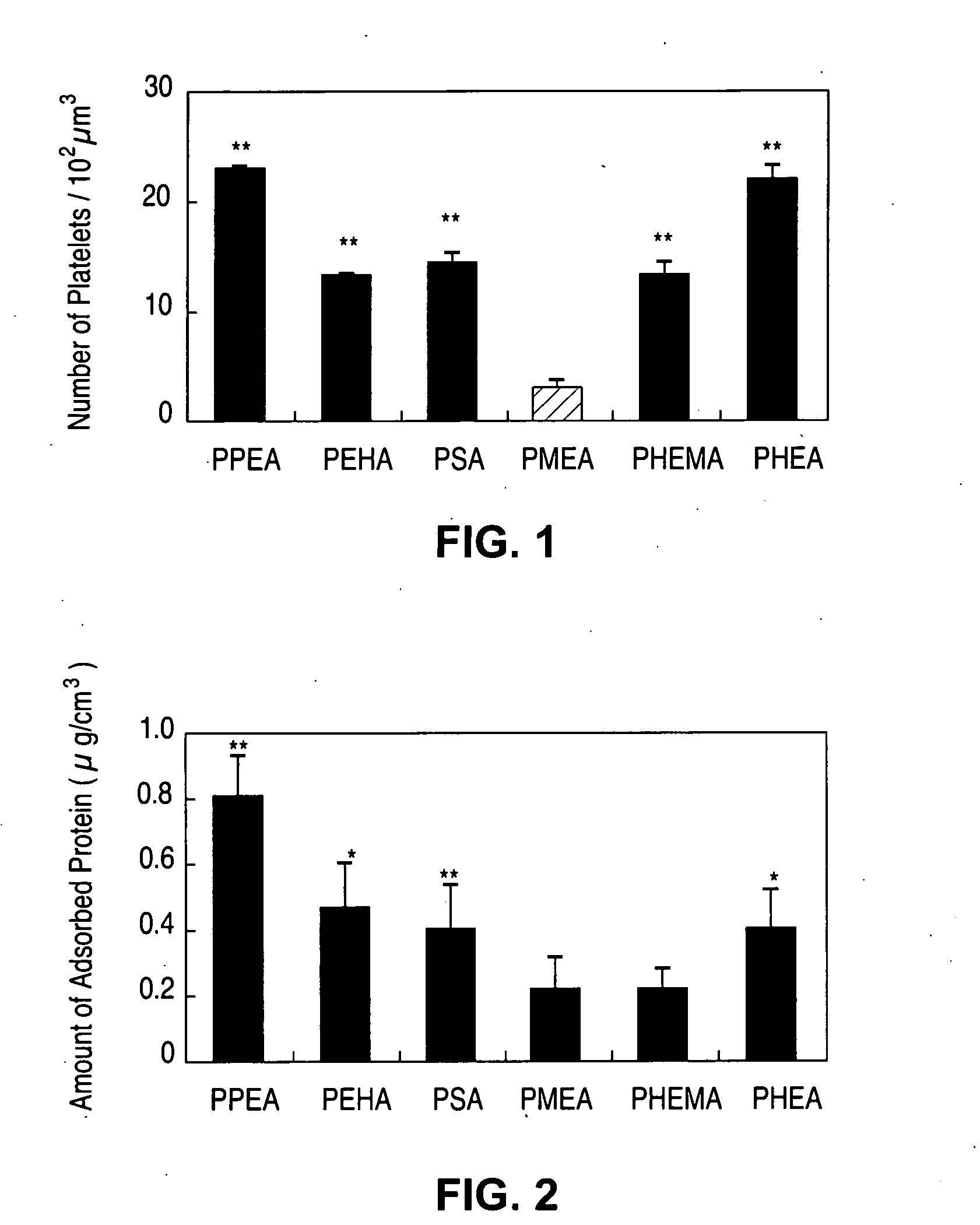Implantable devices formed of non-fouling methacrylate or acrylate polymers
a technology of acrylate polymer and implantable devices, which is applied in the direction of prosthesis, blood vessels, biocide, etc., can solve the problems of current drug-delivery stents, thrombosis of stents, and chronic restnosis
- Summary
- Abstract
- Description
- Claims
- Application Information
AI Technical Summary
Benefits of technology
Problems solved by technology
Method used
Image
Examples
example 1
Hemocompatibility Study of poly(2-methoxyethyl acrylate) (PMEA)
[0038] The measures of in vitro hemocompatibility, including human platelet adhesion, changes in platelet morphology, total absorbed protein from human plasma, amount of absorbed BSA (bovine serum albumin), absorbed human fibrinogen, and changes in protein conformation by circular dichroism of polymers PPEA, PEHA, PEA, PMEA, PHEMA and PHEA were measured (see M, Tanaka M, et al., Biomaterials 21:1471-1481 (2000)). FIG. 1 shows number of platelets adhered to the surface of the polymers (**P<0.01 vs. PMEA, mean±SD, n=5), and FIG. 2 shows the total amount of proteins from human plasma adsorbed onto polymers (*P<0.05 vs. PMEA; **P<0.01 vs. PMEA, mean±SD, n=5). In this statistical analysis, the P value comes from hypothesis testing to determine if, in fact, the levels of protein absorption between the various polymers are equivalent (null hypothesis). Here, P is the probability, on a scale of zero to one, of wrongly rejecting...
example 2
Fabrication of a Polymer-Coated Implantable Medical Device
[0040] Primer Layer
[0041] Poly(n-butyl methacrylate) is dissolved in 1:1 acetone:xylene (by weight) to give a 2% by weight solution. An EFD 780S spray nozzle with a VALVEMATE 7040 control system, manufactured by EFD, Inc., East Providence, R.I. is used to spray the polymer solution onto a stent. During the process of applying the composition, the stent can be optionally rotated about its longitudinal axis, at a speed of 50 to about 150 rpm. The stent can also be linearly moved along the same axis during the application.
[0042] The 2% solution of the polymer is applied to a 12-mm VISION™ stent (available from Guidant Corporation) in a series of 10-second passes, to deposit 10 μg of coating per spray pass. Between the spray passes, the stent is dried for 10 seconds using a flow of air at 80° C. Five spray passes are applied to form a 50 μg primer layer, followed by baking the primer layer at 80° C. for one hour.
[0043] Drug-C...
PUM
 Login to View More
Login to View More Abstract
Description
Claims
Application Information
 Login to View More
Login to View More - R&D
- Intellectual Property
- Life Sciences
- Materials
- Tech Scout
- Unparalleled Data Quality
- Higher Quality Content
- 60% Fewer Hallucinations
Browse by: Latest US Patents, China's latest patents, Technical Efficacy Thesaurus, Application Domain, Technology Topic, Popular Technical Reports.
© 2025 PatSnap. All rights reserved.Legal|Privacy policy|Modern Slavery Act Transparency Statement|Sitemap|About US| Contact US: help@patsnap.com



